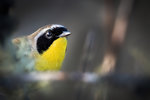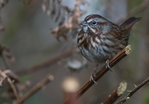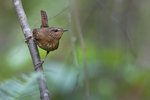


Vocalization – aka singing – is vitally important to nearly all bird species. And with the coming of spring, we are reminded of this every morning as our neighborhood birds are vocalizing to announce their enthusiasm for the coming breeding season.
But not all vocalizations are about claiming territory and breeding. Birds vocalize in both calls and songs. Calls are a very wide variety of noises, sometimes not at all melodious, that serve to let other birds know about location, danger and the like – in essence, routine communication. You often hear an alarm call as a bird takes off from its perch after being startled.
Songs are the vocal performances common in this season. For example, it’s almost impossible this month to be out during good weather and not hear a Song Sparrow male. His song starts abruptly and has 2-6 notes, then ends in a trill. Or, if you in or near a woodland, you will almost certainly hear Pacific Wren males singing their burbling, bouncing notes.
These songs, usually sung only by males, serve two primary purposes: to establish a territory and to attract and keep a mate for the breeding season. Some songbirds may use different songs to defend territory versus attract a mate. And some, like the Common Yellowthroat, use color flashes to enhance their performance, throwing their heads back when singing and flashing his bright yellow throat. And, don’t forget that with the web and cell phones, you can easily download a sight and sound identification app for your phone at http://www.allaboutbirds.org.
Bird researchers have studied bird songs for centuries. All mammals, including we humans, have a larynx (voice box) near the top of our trachea (our windpipe). And, similar to mammals, birds control the volume and pitch of the vocalization with muscles that change the vocal cords and by controlling the volume of air exhaled.
However, the vocal apparatus of birds is quite different. Their “voice box,” termed the syrinx, is located at the connection of the trachea and lungs and has two parts. Thus, some birds manage to sing two separate notes at the same time and, in effect, harmonize with themselves. This is one of the reasons that the voice of some of the thrushes sound so intriguing and eerie.
Do you recall the movie Amadeus, a story about Wolfgang Amadeus Mozart? In one scene the young Mozart demonstrates his ability to instantly master and immediately reproduce musical notes he heard only once. What you likely did not know, however, was that Mozart had a pet starling. These birds are renowned for their musical repertoire; some have argued that Mozart borrowed musical phrases from his pet and from other birds in his compositions.
Much of Mozart’s music is so appealing to the human ear that it might be called perfection. Likewise, the same could be said for the songs of some of our birds. There is some universality that birds have managed to tap into as part of their breeding cycle.
But how do these birds learn to sing? For many species, males continue to sing beyond the initiating of nesting. Thus, male nestlings hear their species “song” from an early age. Researchers, of course, have studied this at length, raising young apart from parents, seeing if they can teach the young a different song, etc. The general conclusion is that young males have an inherent rough song which they practice over time to perfect. Those whose songs are the most like their parent’s song are most able to attract a female partner who also listened to that song from an early age.
Recently paleontologists have identified fossil remains of dinosaurs that suggest that these animals had complicated voice boxes, capable of more than grunts and roars. It’s remarkable to think that music, something we think of as an inherently human domain, actually has been present on earth for millions of years – practiced first by ancient reptiles and now by the birds in our neighborhood.
Cranes – Additional information. One of last month’s columns was about cranes and included the story about the recovery project of the endangered Whooping Crane. I located a 10-year-old YouTube video that showed some of the interesting recovery techniques then employed as part of the recovery program. You can view this interesting video at https://www.youtube.com/watch?v=Ye4Swf3-yDM.
George Walter is environmental program manager at the Nisqually Indian Tribe’s natural resources department; he also has a 40+ year interest in bird watching. Contact him at george@theJOLTnews.com
Photos for this column are provided by Liam Hutcheson, a 15-year-old Olympia area bird enthusiast and avid photographer.
Comments
No comments on this item Please log in to comment by clicking here